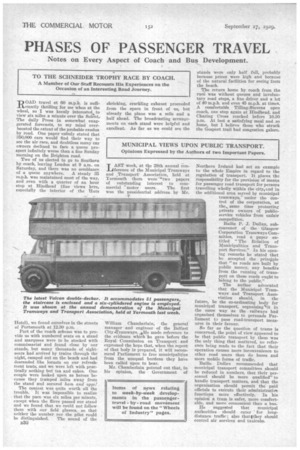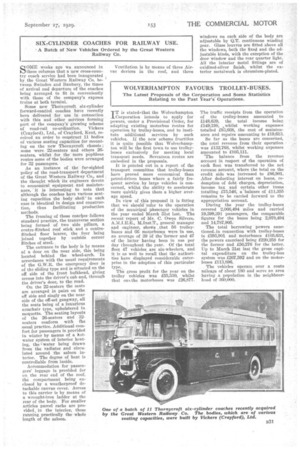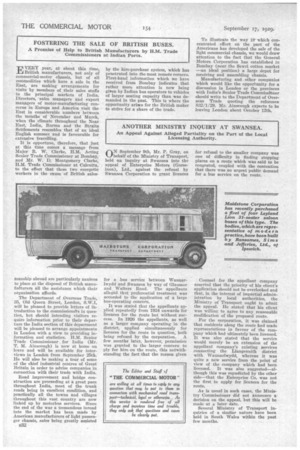PHASES OF PASSENGER TRAVEL
Page 64

Page 65

Page 66

If you've noticed an error in this article please click here to report it so we can fix it.
Notes on Every Aspect of Coach and Bus Development.
ROAD travel at 60 m.p.h. is sufficiently thrilling for me when at the wheel, so I was keenly interested., to view six miles a minute over the Solent. Thedaily Press in somewhat exaggerated forecasts, to my mind overboosted the extent of the probable exodus by road. One paper calmly stated that 350,000 cars would find their way to see the air race, and doubtless many car owners declined to face a queue prospect infinitely worse than a fine Sunday morning on the Brighton road.
Two of us elected to go to Southsea by coach, leaving London at 9 ti.m. on Saturday, and there was no semblance of a queue anywhere. A steady 35 m.p.h. was maintained most of the way, and even with a quarter of an hour stop at Hindhead (fine views here, especially the interior of the Huts Hotel), we found ourselves in the streets of Portsmouth at 12.30 p.m.
Part of the coach scheme was to provide us with numbered seats on a stand and marquees were to be stocked with commissariat and found close by our stands, but many thousands of sightseers had arrived by trains through the night, camped out on the beach and had descended like locusts on our refreshment tents, and we were left with practically nothing but tea and cakes. One couple were looked upon as heroes because they tramped miles away from the stand and secured ham, and eggs!
The contest was quite worth all the trouble. It was impossible to realize that the pace was six miles per minute, except when the fliers passed our stand and we found that we could not follow them with our field glasses, so that neither the number nor the pilot could
be distinguished. The sound of the
shrieking, crackling exhaust proceeded from the space in front of us, but already the plane was a mile and a half ahead. The broadcasting arrangements on each stand were helpful and excellent. As far as we could see the
stands were only half full, probably because prices were high and because of the natural facilities for seeing from the beach.
The return home by coach from the race was without queues and involuntary road stops, a fine driver and a lot of 40 m.p.h. and even 45 m.p.h. at times. A comfortable Tilling-Stevens open coach, one stop again at Hindhead, and Charing Cross reached before 10.30 p.m. At last a satisfying meal and so home, but I believe those who struck the Gosport trail had congestion galore.
TAST week, at the 28th annual Con4 ference of the Municipal Tramways and ,Transport Association, held at Yarmouth there were two papers of outstanding interest to com
mercial " motor users. The first was the presidential address. by Mr.
William Chamberlain, the general manager and -engineer of the Belfast City /Tramways. „V He made reference to the evidence which he gave before the Royal Commission on Transport and expressed the hope that, when the report of that body is prepared, it -will 'recommend Parliament to free municipalities from the unequal burdens they have been called upon to bear.
Mr. Chamberlain pointed out that, in his opinion, the Government of
Northern Ireland had set an example to the whole Empire in regard to the regulation of transport. It places the responsibility for the provision of means for passenger road transport for persons travelling wholly within the city and in the additional area served by municipal tramways,' under the control of the corporation, at thee, same time protecting private owners of publicservice vehicles from unfair competition.
Bailie P. J. Dollen, subconvener, of the Glasgow Corporation Tramways Committee, read a paper entitled "The Relation of Municipalities and Transport Services.". In his opening remarks he stated that he accepted the prinqiple that "as roads are built by public money, any benefits from the running of transport on these roads ought to belong to the public."
The author advocated that the Municipal Tramways and Transport Association should, in the future, be the co-ordinating body for municipal transport, organizinelit in the same way as the railways had organized themselves to persuade Parliament to pass road-transport measures in their favour.
So far as the question of trams is concerned, the point of view appeared to be that public transport by them was the only thing that mattered, no reference being made to the fact that their operation causes more inconvenience to other road users than do buses and more mobile forms of traffic.
Bailie Dollaa recommended that municipal transport committees should he reduced in numbers, that their personnel should be more qualified' to handle transport matters, and that the organization should permit the paid officials to execute their administrative functions more effectively. In his opinion' a tram is safer, more comfortable, and more economical than a bus.
He suggested that municipal authorities should cater for longdistance traffic ; also thatftheY should control air services and taxicabs.
S0141E weeks ago we announced in these columns that a new cross-country coach service had been inaugurated by the Great Western Railway Co. between Swindon and Banbury, the times of arrival and departure of the cOaches being arranged to fit in conveniently with those of the company's express trains at both termini.
Some new Thornycroft six-cylinder forward-control coaches have recently been delivered for use in connection with this and other services forming part of the company's growing scheme of road-rail co-ordination. Vickers (Crayford), Ltd., of Crayford, Kent, received an order to construct 11 bodies of various seating. capacities for mounting on the new Thornycroft chassis ; some were 22-seaters and others 26seaters, whilst for the more pophlous routes some of the bodies were arranged for 32 passengers.
As an instance of the far-sighted policy of the road-transport department of the Great Western Railway Co, and the thought which its engineers devote to economical equipment and maintenance, " it is interesting to note that although the coaches have various seating capacities the body shell in each case is identical in design and construction, thus facilitating production methods.
The framing of these coachesfollows standard practice, the transverse section being formed of two side pillars, a centre-ilitched roof stick and a centreflitched floor bearer, the four being joined together by outside corner flitches of steel.. The entrance to the body is by means of a door on the near side, this being located behind the wheel-arch. In accordance with the usual requirements of the G.W.R. the emergency 'door is of tha sliding type and is situated on the off side of the front bulkhead, giving access into the driver's cab and, through the driver's door, to the road. On the 22-seaters the seats are arranged in pairs on the off side and singly on the near side of the off-set gangway, all the seats being of a luxurious armchair type, upholstered in moquette. The seating layouts of the 26-seaters and 32seaters conform with file usual practice. Additional comfort for passengers is provided in winter by means of a kotwater system of interior heating, thewater being drawn from the radiator and circulated around the saloon interior. The degree of heat is controllable from inside.
Accommodation for passengers' luggage is provided for on the rear end of the roof, the compartment being enclosed by a weatherproof detachable canvas cover. Access to this carrier is by means of a wrought-iron ladder at the rear of the body. For smaller articles parcel racks are provided, in the interior, these running practically the whole length of the saloon. Ventilation is by means of three Airvac devices in the roof, and three windows on each side of the body are adjustable by Q.T. continuous winding gear. Glass louvres are fitted above all tho windows, both the fixed and the adjustable kinds, with the exception of the door window and the rear quarter light. All the interior metal fittings are of oxidized-silver finish, whilst the exterior metalwork is chromium-plated.
TT is stated&that the Wolverhampton 'Corporation intends to apply for powers, under a Provisional Order, for adapting existing motorbus routes for operation by trolley-buses, and to institute additional services by such vehicles. If the new scheme fructifies it is quite Possible that Wolverhampton will be the first town to use trolleybuses exclusively for meeting local transport needs. Seventeen routes are embodied in the proposals.
It is pointed ont in a report of the transport committee that trolley-buses have proved more economical than petrol-driven buses where a fairly frequent service by large vehicles is concerned, whilst the ability to accelerate more quickly gives them a higher average speed.
In view of this proposal it is fitting that w6 should'refer to the operation of the municipal passenger vehicles in the year ended March 31st last. The recent' report of Mr. C. Owen Silvers, A.M.I.E.E., M.Inst.T., general manager and engineer, sbows .that 56 trolleybuses and 66 motorbuses were in use, an average of 39 of the'former and 47 of the latter having been in use per day throughout the year. Of the total fleet 47 vehicles are six-wheelers, and it is as well to recall. that the authorities have displayed considerable enterprise in the adoption of this particular type.,
The gross profit for the year on the trolley vehicles was £55,530, whilst that on the motorbuses was £26,877. The traffic receipts from the operation of . the trolley-buses amounted to £148,639, the total income being £149,198, „whilst working expenses totalled £93,668, the cost of maintenance and repairs amounting to £19,613.
So far as the buses are concerned, the total revenue from their operation was £132,768, whilst working expenses amounted to £105,111.
'The balance from the revenue account in respect of the operatiOn of each fleet was transferred to the net revenue account, where the total on the credit side was increased to £86,901. After deducting interest on loans, redemption of debt charges, depreciation, income tax mid certain other items totalling £75,546, a' balance of £11,355 remains to be carried forward to the appropriation account.
Wring the year the trolley-buses. covered 2,066,494 miles and carried 19,399,391 passengers, the comparable figures for the buses being 2,079,494 and 14,787,905.
The total borrowing powers sanetioned.in connection with trolley-buses is £393,901 and motorbuses £105,633, the powers exercised being £220,258 for the former and £56,276 for the latter. Up to March 31st last the gross capital expenditure on the trolley-bus system was £267,592 and on the motorbuses £113,896.
The vehicles operate over a route mileage of about 180 and serve an area having a population in the neighbourhood of 360,000.
'V VERY year, at about this time, A I' British manufacturers, not only of commercial-motor chassis, but of all commodities which have a sale in the East, are making arrangements for visits by members of their sales staffs to the principal markets of India. Directors, sales managers and export managers of motor-manufacturing concerns in Europe and America visit the East in considerable numbers between the months of November and March, when the .climate throughout the Near East, India, Burma and the Straits Settlements resembles that of an ideal English summer and is favourable for extensive travelling.
It is opportune, therefore, that just at this time comes a message from Major R. W. Clarke, H.M. Acting Senior Trade Commissioner at Bombay, and Mr. W. D. Montgomery Clarke, 11.M. Trade COmmissioner at Calcutta, to the effect that these two energetic workers in the cause of British sales
manship abroad are particularly anxious to place at the disposal of British menufaeturers all the assistance which their organization affords.
The Department of Overseas Trade, 35, Old Queen Street, London, S.W.1, will be pleased to provide letters of introduction to the commissione'rs in question, but should intending visitors require information prior to their departure the India section of this department will be pleased to arrange appointments in London with a view to providing information and statistics. 11.M. Senior Trade Commissioner for India (Mr. T. M. Ainscough) is now at home on leave and will be available for interviews in London from September 25th. He will also be making a tour of some of the chief industrial centres of Great Britain in order to advise companies in connection with their trade with India.
Road improvement and bridge construction are proceeding at a great pace throughout India, most of the trunk roads being in excellent condition, and practically all the towns and villages throughout this vast country are now linked up by motorbus services. Since the end of the war a tremendous inroad into the market has been made by American manufacturers of light passenger chassis, sales being greatly assisted B32
by the hire-purchase system, which has penetrated into the most remote corners. First-hand information which we have received from Bombay indicates that rather more attention is now being given by Indian bus operators to vehicles of larger seating capacity than was demanded in the past. This is where the opportunity arims for the British maker to strive for a share of the trade. To illustrate the way in which concentrated effort on the part of the Americans has developed the sale of the light commercial chassis, we would draw attention to the fact that the General Motors Corporation has established in Bombay (near the Sewn i cotton market —an ideal position) a large depot for receiving and assembling chassis.
Manufacturing and other companies which would like the opportunity for a discussion in London or the provinces with India's Senior Trade Commisetmer should write to the Department of Overseas Trade quoting the reference 532/1/29. Mr. Ainscough expects to be leaving London about October 12th, ON September 9th, Mr. P. Gray, on behalf of the Ministry of Transport, held an inquiry at Swansea into the appeal of Enterprise Motors (Gorseinon), Ltd., against the refusal by Swansea Corporation to grant licences for a -bus service between Wannarlwydd and Swansea by way of Glaumor and Walters Road. The appellants alleged that preferential treatment was accorded to the application of a large bus-operating concern.
It was stated that the appellants applied repeatedly from 1924 onwards for licences for the route but without success. In 1926 the appellants, as well as a larger company operating in the district, applied simultaneously for licences for the route in question, both being refused by the corporation. A few months later, however, permission was granted to the larger concern to ply for hire on the route, this notwithstanding the fact that the reason given for refusal to the smaller company was one of difficulty in finding stopping places on a route which was said to be congested, coupled with the contention that there was no urgent public demand for a bus service on the route.
Counsel for the appellant company asserted that the priority of his client's application should not be overlooked and that, in the interest of impartial administration by local authorities, the Ministry of Transport ought to admit the appeal. He stated that his client was willing to agree to any reasonable modification of the proposed route.
For the corporation, it was claimed that residents along the route had made representations in favour of the company which had ultimately been licensed. It was also stated that the service would merely be an extension of the appellant company's existing services connecting the Llangennith district with Waunarlwydd, whereas it was quite a new service from the point of view of the company which had been licensed. It was also suggested—although this was repudiated by the other side—that the Enterprise Co. was not the first to apply for licences for the route.
As is usual in such cases, the Ministry Commissioner did not announce a decision on the appeal, but this will be made at a later date.
Several Ministry of Transport inquiries of a similar nature have been held in South Wales within the past few months.




















































































































